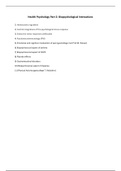Summary
Samenvatting Health Psychology Part 2 - Biopsychological Interactions
- Course
- Institution
Totale samenvatting van college aantekeningen en slides van alle lessen (inclusief les zelfstudie) van het vak 'Health Psychology Part 2 - Biopsychological Interactions' gegeven door prof. dr. Andreas von Leupoldt voor de master psychologie, master bio-ingenieurswetenschappen biosysteemtechniek en ...
[Show more]



